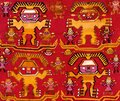Art: Difference between revisions
(Added stub intro.) |
No edit summary |
||
| Line 1: | Line 1: | ||
An intriguing characteristic of the Nazca mummies is the presence of tridactyl or three-fingered anatomy, a feature not unique to ancient Peru but also observed in various other regions worldwide, including Japan, Indonesia, and the United States. These creatures are frequently portrayed with distinctive attributes such as three digits on their hands and feet, prominent circular eyes, triangular body shapes, and pointed, elf-like hats and footwear. The following examples illustrate the global occurrence of these tridactyl beings across diverse cultures and geographical locations. | |||
=== Peru === | |||
==== Nazca ==== | |||
<gallery> | |||
Peru1.jpg | |||
Peru2.jpg | |||
Peru3.png | |||
</gallery> | |||
==== Chimu ==== | |||
<gallery> | |||
Chimu1.jpg | |||
Chimu2.jpg | |||
Chimu3.jpg | |||
</gallery> | |||
==== Paracas ==== | |||
<gallery> | |||
Paracas1.jpg | |||
Paracas2.jpg | |||
</gallery> | |||
=== Argentina === | |||
<gallery> | |||
Argentina1.png | |||
Argentina2.png | |||
Argentina3.png | |||
</gallery> | |||
=== Links === | === Links === | ||
Revision as of 03:48, 11 April 2024
An intriguing characteristic of the Nazca mummies is the presence of tridactyl or three-fingered anatomy, a feature not unique to ancient Peru but also observed in various other regions worldwide, including Japan, Indonesia, and the United States. These creatures are frequently portrayed with distinctive attributes such as three digits on their hands and feet, prominent circular eyes, triangular body shapes, and pointed, elf-like hats and footwear. The following examples illustrate the global occurrence of these tridactyl beings across diverse cultures and geographical locations.










